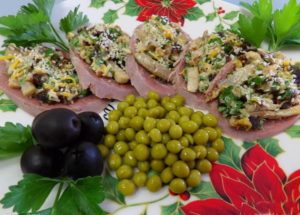“The cohanim will have the right to receive from the people, from those offering a sacrifice, whether ox or sheep, the shoulder, the jowls and the stomach. You will also give him the firstfruits of your grain, new wine and olive oil, and the first of the fleece of your sheep. For Adonai your God has chosen him from all your tribes to stand and serve in the name of Adonai, him and his sons forever.”-Deuteronomy 18:3-5
Verses 3-5 of Deuteronomy 18 deal with how the priests and Levites were to maintain their livelihood.
We’re told their main means of support was to come from the firstlings offered by the members of the other 12 tribes of Israel.
When I say “firstlings”, I’m referring to the firstborn animal sacrifices as well as the firstfruits from the field and the tree crops.
Quite a ways back when we were deep in the Book of Leviticus, we went into insane detail studying the many specific classifications of the sacrifices and how each of them carried a different protocol and purpose.
Well, connected to this, in verse 1 we’re told that the Priests and Levites were to keep back a portion of the “food offerings” being presented to the Lord for their sustenance.
Many English Bibles call this group of sacrifices “fire offerings”.
However, understand that these “fire offerings” are actually different than the “burnt offerings” or the OLAH we studied in Leviticus.
The original Hebrew here for “fire offerings” here is ISHSHEH.
So what’s the difference between the ISHSHEH (fire offerings) and the OLAH (burnt offerings)?
The biggest difference is this.
The ISHSHEH represents those series of sacrifices where only a portion of the animal is burned up on the brazen altar …
…AND…
…a larger portion is set aside for the clergy’s food.
On the other hand, the OLAH is that class of sacrifice where the whole animal is completely consumed to a crisp on the brazen altar.
Not one bit of it was allowed to be eaten by anyone.
At this point, a common question that often comes up is…
…was all the meat from the sacrificed animal placed on the Altar fire…
…and then afterwards some of it taken for food?
The answer is a strong NO.
The portions of the sacrificial animal that were to be used for food were NOT placed on the altar fire.
This wasn’t a Sunday picnic barbecue where all the meat was cooked on a communal grill and anyone could just reach out and snatch a rib or burger as he or she pleased.
All the meat placed on the brazen altar was to be burnt to a toasty black crisp to the point of ashes.
Onward.
When used as “fire offerings”, there were three specific parts of the various sacrificial animals that were to be set aside as food for the priests and the Levites.
They were…
-the shoulder
(the upper part of the right foreleg extending from shoulder to knee)
-the internal organs
(also referred to as the “fourth stomach”)
…and…
-the meat from the head
(referring to the jowls and tongue)
In our day and age, we don’t usually consider the “internal organs” and the “meat from the head” as food.
We usually throw these parts away as waste meat.
But this was NOT the case in Bible times.
All cultures in the ancient Middle East (not just the Hebrews) prized the internal organs as well as the jowls and tongue as good and delicious portions of the meat.
Finally, it wasn’t just the meat portions that were to go to the priests.
They were also to receive the First Fruits of the grain and fruit.
And in addition to the agricultural produce, the Levitical clergy was also to receive olive oil, wine and even the wool from the sheerings of the sheep!




Leave a Reply